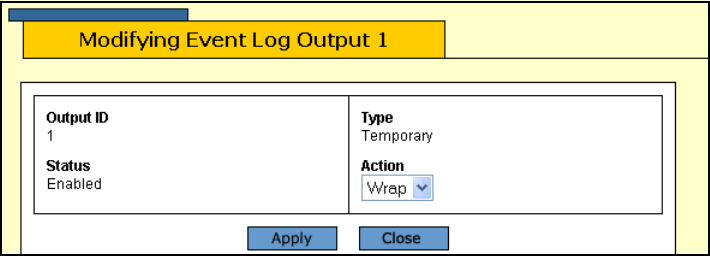User Manual
Table Of Contents
- Contents
- Figures
- Preface
- Section I
- Basic Operations
- Chapter 1
- Starting a Web Browser Management Session
- Chapter 2
- Basic Switch Parameters
- Chapter 3
- Enhanced Stacking
- Chapter 4
- SNMPv1 and SNMPv2c Community Strings
- Chapter 5
- Port Parameters
- Chapter 6
- MAC Address Table
- Chapter 7
- Static Port Trunks
- Chapter 8
- Port Mirroring
- Section II
- Advanced Operations
- Chapter 9
- File System
- Chapter 10
- File Downloads and Uploads
- Chapter 11
- Event Log and Syslog Servers
- Chapter 12
- Classifiers
- Chapter 13
- Access Control Lists
- Chapter 14
- Quality of Service
- Chapter 15
- Class of Service
- Chapter 16
- IGMP Snooping
- Chapter 17
- Denial of Service Defense
- Chapter 18
- Power Over Ethernet
- Section III
- SNMPv3 Operations
- Chapter 19
- SNMPv3
- Enabling the SNMP Protocol
- Configuring the SNMPv3 User Table
- Configuring the SNMPv3 View Table
- Configuring the SNMPv3 Access Table
- Configuring the SNMPv3 SecurityToGroup Table
- Configuring the SNMPv3 Notify Table
- Configuring the SNMPv3 Target Address Table
- Configuring the SNMPv3 Target Parameters Table
- Configuring the SNMPv3 Community Table
- Displaying SNMPv3 Tables
- Section IV
- Spanning Tree Protocols
- Chapter 20
- Spanning Tree, Rapid Spanning Tree, and Multiple Spanning Tree Protocols
- Section V
- Virtual LANs
- Chapter 21
- Port-based and Tagged Virtual LANs
- Chapter 22
- GARP VLAN Registration Protocol
- Chapter 23
- Protected Ports VLANs
- Section VI
- Port Security
- Chapter 24
- MAC Address-based Port Security
- Chapter 25
- 802.1x Port-based Network Access Control
- Section VII
- Management Security
- Chapter 26
- Encryption Keys, PKI, and SSL
- Chapter 27
- Secure Shell Protocol
- Chapter 28
- TACACS+ and RADIUS Authentication Protocols
- Chapter 29
- Management Access Control List
- Index

AT-S62 Management Software Web Browser Interface User’s Guide
Section II: Advanced Operations 127
The columns in the log are described below:
S (Severity) - The event’s severity. Table 2 on page 124 defines the
different severity levels.
Date/Time - The date and time the event occurred.
Event ID - A unique number that identifies the event. (Displayed only in
the Full display mode.)
Filename:Line - The subpart of the AT-S62 module and the line
number that generated the event. (Displayed only in the Full display
mode.)
Event - The module within the AT-S62 software that generated the
event followed by a brief description of the event. For a list of the
AT-S62 modules, see Table 3 on page 125.
Modifying the
Event Log Full
Action
This procedure explains how to control what the log will do once it reaches
its maximum capacity of 4,000 events. You have two options. The first is to
have the switch delete the oldest entries as it adds new entries to the log.
The second is to have the switch stop adding entries, so as to preserve the
existing log contents.
This procedure is only relevant when viewing the event log through a local
or remote management session. If you defined syslog servers, the switch
continues to send events to a syslog server even when the log is full.
To configure the event log, do the following procedure:
1. From the Home Page, click either Configuration.
2. Select the System menu option.
3. Select the Event Log tab.
The Event Log tab is shown in Figure 29 on page 123.
4. Under Current Log Outputs, select Output 1, Temporary, and click
Modify. The Modifying Event Log Output 1 window is shown in Figure
31.
Figure 31. Modifying Event Log Output 1 Window










